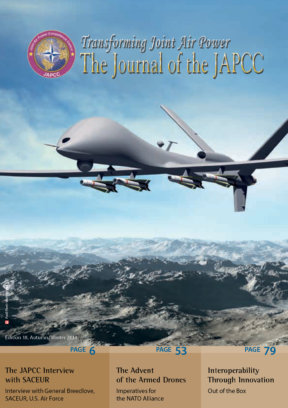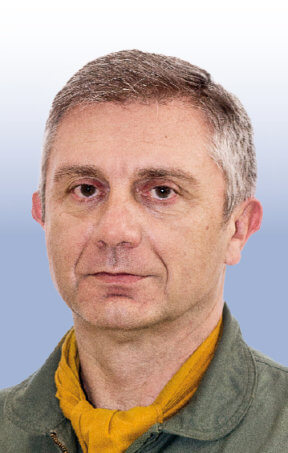Introduction
Independent Air Power has been an enduring theme of military aviation since man first took to the skies. It underpinned the establishment of air forces and led some airmen to adopt particularly firm views on the ‘correct’ use of air power. But this debate has clouded the real issue and made an examination of the proper independent application of air power a challenging topic. Afghanistan saw a predominantly auxiliary application of air power, but is that the enduring model for the future? In what ways can air power be integrated with diplomatic and political action to bring about crisis resolution without the need for extensive surface deployments? Can air power act in a wider containment role without the establishment of extensive deployed infrastructure?1
The widely recognised definition of Air Power is the one coined by the British MOD. Air Power is described as “the capacity and ability to project national or alliance power from air and space to influence the behaviour of people or the course of events”.
With the Chicago Summit Declaration (20 – 21 May 2012), the Heads of state of NATO have agreed that: through the UN-mandated Operation Unified Protector (OUP), and with the support of the League of Arab States, our Alliance played a crucial role in protecting the civilian population in Libya and in helping save thousands of lives (…). It is always difficult to measure the success of a military operation; often only history will disclose the truth. What is incontestable is that, for the Alliance, Air Power in Lybia has been playing solo and it has influenced both the behaviour of people and the course of events.
Changing Balance
When we refer to air power, we don’t mean single service, the army and navy took part to the endeavour, through different even sophisticated declination of air power but still air power.
What was really revolutionary in the Operation Unified Protector was from a political and military perspective the absence of coalition’s ‘boots on the ground’ or at least that the air phase was not preparing any allied land activity.
In 2the edition number 8 of our journal, only three years prior Operation Unified Protector, we wrote that in irregular warfare it was crucial to have an effective air land integration with small and often isolated Land units, who use mission command to conduct HUMINT-led operations and interface with local population. A mantra of centralised control decentralised execution will result in unmatched Joint, Air and Land command and control constructs, which leave Air as a responsive tactical level activity rather than shaping activity at all levels.
Were we short sighted at the time? Or just trying to adapt, rewrite a doctrine shaped for symmetric warfare to the new fragmented scenarios. In a time of rapid changes, history ran faster than ideas and Air Power during this period was either the main or the sole tool employed by the alliance.
Governments are no longer eager to send land troops to overseas operations if the vital interests of the nations are not directly threatened. Land / joint operations demand a different level of investment both moral and economical; operations are more demanding in economic and moral terms. Public opinion is not tolerating the personnel losses witnessed in the last decades; Deploying and redeploying of land units is a demanding complex activity. Our illustrious ‘colleague’ and celebrated poet Antoine de Saint Exupery quoted in his celebrated novella the Little Prince: “You become responsible, forever, for what you have tamed”, taming in this case can’t be interpreted as changing the course of events, changing the behaviour of people.
Is air power too strong, too decisive and at the same time too volatile? Is it ethical to change the course of events without our presence on the ground?
Air Power in Isolation
Shall Air Power in isolation be considered the preferred option for the military interventions of the Alliance or only a necessary component of a joint set up? Our heads of state, again in the Chicago declaration affirm again:
Our successful operation in Libya showed once more that the Alliance can quickly and effectively conduct complex operations in support of the broader international community. We have also learned a number of important lessons which we are incorporating into our plans and policies …
In a perfect world there would be no conflict, but if we have to fight, we (the military) like to have all the pieces on our chessboard; kings, queens, rooks, bishops, knights and pawns, all moving along the traditional patterns. NATO doctrine and its capstone documents AJP 01 Allied Joint Doctrine and AJP 3.3 Joint Air & Space Doctrine, of which the JAPCC is the proud custodian, are a triumph of the joint mind-set incorporating the lessons learned of the recent joint experiences in the Balkans, Iraq, Afghanistan and the heritage of the of The Cold War era well reflected by the Latin adage “Si vis pacem, para bellum” (if you want peace, prepare for war).
Soldiers don’t like to have all the pieces on the chessboard because they are nice to have; every piece performs a specific role complementary and synergetic, every piece has his own talents and responsibilities. Even still, Air Power has been employed in almost perfect isolation and it performed well or at least accomplished the mission. In this fast moving world, Politics doesn’t wait on doctrine upgrades to give tasks to the military and ‘what to do’ comes before the ‘how to do’ and despite vacuums in the doctrine, our men did it.
It is probable that NATO may face a variety of crises in the future: “Ethnic, political and religious rivalries, territorial disputes, disputes over vital resources, inadequate or failed efforts at reform, the abuse of human rights and the dissolution of states could lead to local and regional instability. The resulting tensions could create a wide spectrum of consequences, ranging from the need to provide humanitarian assistance to armed conflict.”3 It is foreseeable as well that politics will be reluctant to employ ground troops. Will the OUP model become a paradigm for new operations? Shall we incorporate its lesson learned in the relevant doctrine? Wouldn’t it be appropriate to provide our crews and commands a coherent set of rules and guidance in case of employ of air power in isolation? Shall we review the targeting process? Why, during OUP, despite the small numbers, was it deemed so important to carry on shipboard operations with attack helicopters? Was it testing a capability? Was it the research of a psychological effect?









